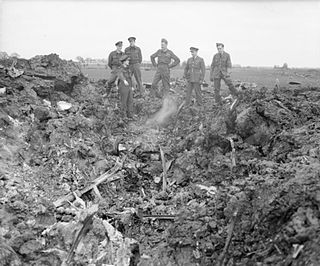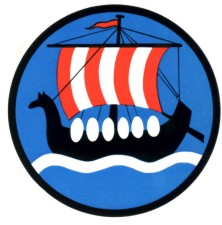
A naval mine is a self-contained explosive weapon placed in water to damage or destroy surface ships or submarines. Similar to anti-personnel and other land mines, and unlike purpose launched naval depth charges, they are deposited and left to wait until, depending on their fuzing, they are triggered by the approach of or contact with any vessel.

The Blitz was a German bombing campaign against the United Kingdom, from 7 September 1940 to 11 May 1941, for slightly over 8 months during the Second World War.

The Heinkel He 111 is a German airliner and medium bomber designed by Siegfried and Walter Günter at Heinkel Flugzeugwerke in 1934. Through development, it was described as a "wolf in sheep's clothing". Due to restrictions placed on Germany after the First World War prohibiting bombers, it was presented solely as a civil airliner, although from conception the design was intended to provide the nascent Luftwaffe with a heavy bomber.

A dive bomber is a bomber aircraft that dives directly at its targets in order to provide greater accuracy for the bomb it drops. Diving towards the target simplifies the bomb's trajectory and allows the pilot to keep visual contact throughout the bomb run. This allows attacks on point targets and ships, which were difficult to attack with conventional level bombers, even en masse.

A strategic bomber is a medium- to long-range penetration bomber aircraft designed to drop large amounts of air-to-ground weaponry onto a distant target for the purposes of debilitating the enemy's capacity to wage war. Unlike tactical bombers, penetrators, fighter-bombers, and attack aircraft, which are used in air interdiction operations to attack enemy combatants and military equipment, strategic bombers are designed to fly into enemy territory to destroy strategic targets. In addition to strategic bombing, strategic bombers can be used for tactical missions. There are currently only three countries that operate strategic bombers: the United States, Russia and China.

The Dornier Do 217 was a bomber used by the German Luftwaffe during World War II. It was a more powerful development of the Dornier Do 17, known as the Fliegender Bleistift. Designed in 1937-38 as a heavy bomber but not meant to be capable of the longer-range missions envisioned for the larger Heinkel He 177, the Do 217's design was refined during 1939 and production began in late 1940. It entered service in early 1941 and by the beginning of 1942 was available in significant numbers.

The Heinkel He 115 was an all-metal twin-engined military seaplane designed and produced by the German aircraft manufacturer Heinkel. Early on its flying history, the He 115 established several new international records for floatplanes.
Kampfgeschwader 200 was a German Luftwaffe special operations unit during World War II. The unit carried out especially difficult bombing and transport operations and long-distance reconnaissance flights, tested new aircraft designs and operated captured aircraft.

A blockbuster bomb or cookie was one of several of the largest conventional bombs used in World War II by the Royal Air Force (RAF). The term blockbuster was originally a name coined by the press and referred to a bomb which had enough explosive power to destroy an entire street or large building through the effects of blast in conjunction with incendiary bombs.

An anti-handling device is an attachment to or an integral part of a landmine or other munition such as some fuze types found in general-purpose air-dropped bombs, cluster bombs and sea mines. It is designed to prevent tampering or disabling, or to target bomb disposal personnel. When the protected device is disturbed, it detonates, killing or injuring anyone within the blast area. There is a strong functional overlap of booby traps and anti-handling devices.

Kampfgeschwader 55 "Greif" was a Luftwaffe bomber unit during World War II. KG 55 was one of the longest serving and well-known in the Luftwaffe. The wing operated the Heinkel He 111 exclusively until 1943, when only two staffeln of its four Gruppen (Groups) used the Junkers Ju 88C.

Operation Steinbock or Operation Capricorn, sometimes called the Baby Blitz or Little Blitz, was a strategic bombing campaign by the German Air Force during the Second World War. It targeted southern England and lasted from January to May 1944. Steinbock was the last strategic air offensive by the German bomber arm during the conflict.

Kampfgeschwader 3 "Blitz" (KG 3) was a Luftwaffe bomber wing during World War II.

The Heinkel He 111 was one of the most numerous German bombers of the Second World War. Designed in the mid-1930s, the type persevered until 1945. In Spain, variants of the design saw service until 1973.

Kampfgeschwader 1 was a German medium bomber wing that operated in the Luftwaffe during World War II.
Coastal Command was a formation within the Royal Air Force (RAF). Founded in 1936, it was to act as the RAF maritime arm, after the Fleet Air Arm became part of the Royal Navy in 1937. Naval aviation was neglected in the inter-war period, 1919–1939, and as a consequence the service did not receive the resources it needed to develop properly or efficiently. This continued until the outbreak of the Second World War, during which it came to prominence. Owing to the Air Ministry's concentration on Fighter Command and Bomber Command, Coastal Command was often referred to as the "Cinderella Service", a phrase first used by the First Lord of the Admiralty at the time A. V. Alexander.
The Secret War was a six-part television series that was produced by the BBC in conjunction with the Imperial War Museum (IWM) that documented secret technical developments during the Second World War. It first aired during 1977 and was presented by William Woollard, drawing on the first-hand recollections of participants from both sides. The principal interviewee was R. V. Jones, whose autobiography informed much of the research before its publication. The opening music was an excerpt from Pictures at an Exhibition#9. The Hut on Hen's Legs from Mussorgsky's Pictures at an Exhibition. The closing music was by the BBC Radiophonic Workshop.

Kampfgeschwader 40 was a Luftwaffe medium and heavy bomber wing of World War II, and the primary maritime patrol unit of any size within the Luftwaffe. It is best remembered as the unit operating a majority of the four-engine Focke-Wulf Fw 200 Condor maritime patrol bombers. The unit suffered from the poor serviceability and low production rates of the Fw 200 bombers, and from repeated diversion of its long-haul capability aircraft to undertake transport duties in various theatres, especially for the airlift operations to supply encircled forces in the Battle of Stalingrad. Later in the war, KG 40 became one of several Luftwaffe bomber wings to use the Heinkel He 177A heavy bomber.

Kampfgeschwader 100 was a Luftwaffe medium and heavy bomber wing of World War II and the first military aviation unit to use a precision-guided munition in combat to sink a warship on 9 September 1943.


















